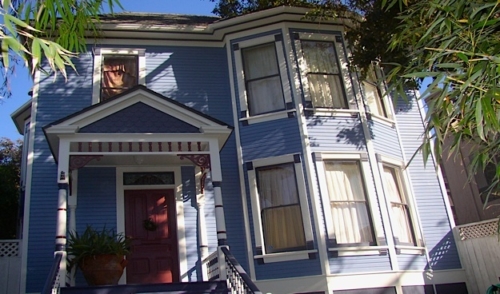Moses Hostetter House

- Known As
- Third Street Historic Neighborhood District, Victorian
- Architect
- Unknown
- Built
- 1893
- Designated
- April 12, 1990
This Victorian house, one of Santa Monica’s oldest buildings, was originally the residence of Moses and Mary Hostetter and their son William. Moses Hostetter had been a farmer in the Midwest before moving to Santa Monica in 1893. Once here he purchased seven lots, for about $45 each, in Ocean Park. Hostetter selected 2601 Second Street for his own home and subsequently built this Victorian. Moses Hostetter was active in city government, serving on the Board of Trustees (similar to today’s City Council). He also worked on improving Santa Monica’s police, light, sewer, and fire services. 2601 Second Street remained in the Hostetter family until 1921.
When the Hostetter house was built, Ocean Park was still in the early stages of development. Serious settlement had begun just a decade earlier when parts of the area were subdivided, and Ocean Park had only formally become part of Santa Monica in 1886. But Ocean Park was on the rise and the Outlook newspaper reported that many of the new homes being built in the area were, “not mere shacks, but they will be neat and commodious…being put up by first-class tenents.” This assessment certainly fits the Victorian-style Hostetter House.
In the 1890s, Victorian styles were the rage all across America. As newcomers flocked to Southern California and built new towns, they often elected to build in this familiar style. Many such structures were highly ornate affairs, making free use of inexpensive, mass-produced ornaments and reveling in picturesque features. The Hostetter house is rather restrained in this respect, but still exhibits many well-known Victorian elements. These include an asymmetrical façade, featuring a two-story bay window. Another two-story bay window on the north side of the house is capped by a turreted roof. (Originally the house boasted a steep gable that sat atop the current roof, adding additional interest to the roofline.) Tall and relatively narrow sash windows help emphasize the structure’s overall verticality. The use of clapboard siding, accented with decorative fishscale shingles, on exterior walls is typically Victorian. The entrance porch, crowned with a pediment, is also distinctively Victorian in its scrolled wooden brackets, turned posts, and spindles. Wooden spindles also support the stair handrails.
The Hostetter house is a preservation success story. It was in tear-down condition in the 1970s, having suffered a period of neglect, but dedicated owners Jan Zeiser and Ken Golick restored the home to its current fine condition. Flanked by mature trees and enclosed behind a white picket fence, the Hostetter house is a worthy anchor to an area rich with history.
Sources:
- Robin Guild. The Victorian House Book. New York: Rizzoli International Publications, 1989.
- “Historic District Application for Third Street Neighborhood Historic District in Ocean Park,” Santa Monica: July 1990. (Available at the Main Santa Monica Public Library.)
- Sam Hall Kaplan. LA Lost & Found: An Architectural History of Los Angeles. New York: Crown Publishers, 1987.
- Outlook, “This Old House,” April 17, 1990.
- Santa Monica Mirror, “A Distinguished Man’s Distinguished House,” April 2-8, 2003.
- Paula A. Scott. Santa Monica: A History on the Edge. Charleston SC: Arcadia Publishing, 2004.
- Staff Report on 2601 Second Street, Moses Hostetter House. City Planning Division, Santa Monica.